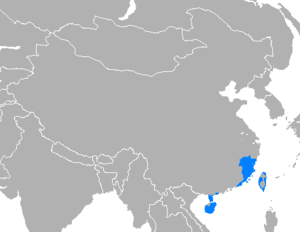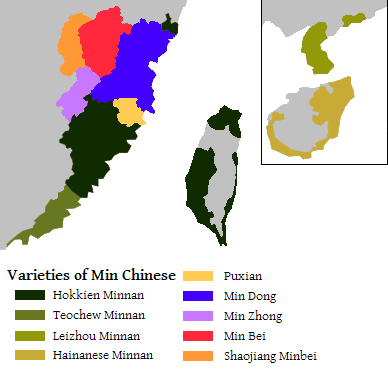Min Chinese
| Min | |
|---|---|
| 閩語/闽语 | |
| Geographic distribution: | Mainland China: Fujian, Guangdong (around Chaozhou-Swatou, Leizhou peninsula and part of Zhongshan), Hainan, Zhejiang-Shengsi, Putuo and Wenzhou, Jiangsu- Liyang and Jiangyin; Taiwan (Overseas, United States-New York City) |
| Linguistic classification: |
|
| Proto-language: | proto-Min |
| Subdivisions: | |
| ISO 639-6: | mclr |
| Glottolog: | minn1248[1] |
 | |
| Min Chinese | |||||||||||||||||
|
Bân gú / Mìng ngṳ̄ ('Min') written in Chinese characters | |||||||||||||||||
| Traditional Chinese | 閩語 | ||||||||||||||||
|---|---|---|---|---|---|---|---|---|---|---|---|---|---|---|---|---|---|
| Simplified Chinese | 闽语 | ||||||||||||||||
| Hokkien POJ | Bân gú | ||||||||||||||||
| |||||||||||||||||

Min or Miin[lower-alpha 1] (simplified Chinese: 闽语; traditional Chinese: 閩語; pinyin: Mǐn yǔ; Pe̍h-ōe-jī: Bân gú; BUC: Mìng ngṳ̄) is a broad group of Chinese languages spoken by over 70 million people in the southeastern Chinese province of Fujian as well as by migrants from this province in Guangdong (around Chaozhou-Swatou, or Chaoshan area, Leizhou peninsula and Part of Zhongshan), Hainan, three counties in southern Zhejiang, Zhoushan archipelago off Ningbo, some towns in Liyang, Jiangyin City in Jiangsu province, and Taiwan. The name is derived from the Min River in Fujian.
There are many Min speakers among overseas Chinese in Southeast Asia as well as in New York City in the United States. The most widely spoken variety of Min outside Fujian is Hokkien (which includes Taiwanese and Amoy). Within Fujian, the Fuzhou dialect is considered the standard.
Classification of varieties
Min is usually described as one of seven or ten groups of varieties of Chinese but has greater dialectal diversity than any of the other groups. The varieties used in neighbouring counties, and in the mountains of western Fujian even in adjacent villages, are often mutually unintelligible.[2]
Early classifications, such as those of Li Fang-Kuei in 1937 and Yuan Jiahua in 1960, divided Min into Northern and Southern subgroups.[3][4] However, in a 1963 report on a survey of Fujian, Pan Maoding and colleagues argued that the primary split was between inland and coastal groups. A key discriminator between the two groups is the evolution of the voiced and unvoiced lateral consonants reconstructed in the ancestral form of Min. In coastal dialects these merged as /l/, while in inland dialects the voiceless lateral became a voiceless fricative /s/ or /ʃ/.[4][5] While coastal dialects can be derived from a proto-language with four series of stops or affricates at each point of articulation (e.g., /t/, /tʰ/, /d/, and /dʰ/), inland dialects contain traces of two further series, which Norman termed "softened stops" due to their reflexes in some dialects.[6][7] Coastal dialects also feature some uniquely Min vocabulary, including pronouns and negatives, where inland dialects use forms cognate with vocabulary in Hakka and Yue.[8]
Pan et al. divided the coastal dialects into three groups:[9]
- Southern Min (Min Nan) originates from the south of Fujian and the eastern corner of Guangdong. In common parlance, Southern Min usually refers to Hokkien, of which the two major poles are the Amoy dialect of Xiamen and Taiwanese Hokkien of Taiwan. The Zhenan dialect of Cangnan County in southern Zhejiang is also of this type. Related Hokkien dialects are spoken in Chinese communities spread across Southeast Asia.[10] The Teochew and Shantou dialects of the Chaoshan region of eastern Guangdong have difficult mutual intelligibility with the Amoy dialect. Chaoshan dialects are also spoken by most Thai Chinese.[4]
- Pu-Xian Min originated as a Southern Min dialect, which underwent major phonological influence from Eastern Min.
- Eastern Min (Min Dong), centered around the city of Fuzhou, the capital of Fujian province, with Fuzhou dialect as the prestige form.
Pan et al. divided the inland dialects into two groups:[9]
- Northern Min (Min Bei) is spoken in Nanping prefecture in Fujian, with Jian'ou dialect taken as typical.
- Central Min (Min Zhong), spoken in Sanming prefecture.
The Language Atlas of China (1987) includes three additional groups besides the five identified by Pan et al.:[11]
- Shaojiang dialects, spoken in the northwestern Fujian counties of Shaowu and Jiangle, were classified as Hakka by Pan and his associates.[4] However, Jerry Norman suggested that they were inland Min dialects that had been subject to heavy Gan or Hakka influence.[12]
- Leizhou Min, spoken on the Leizhou Peninsula in southern Guangdong, had previously been included in Southern Min.
- Hainanese, spoken on the island of Hainan, had also previously been included in Southern Min.
New researches have shown that both Hainanese-Leizhou and Putian Min should be grouped under Greater Minnan because of their origins as Minnan language with a lot of cognates with the other Minnan dialects.
| Min |
| ||||||||||||||||||||||||||||||||||||||||||||||||||||||||||||||||||||||||||||||||||||||||||||||||||||||||||||
| |
History
There are controversies among scholars about when Min Chinese initially emerged as a recognizable dialect group. But it is generally consensus that several huge immigrations from Zhongyuan greatly shaped and influenced Min Chinese. By the Middle Chinese period, Min Chinese had already split off,[13] just like Ba-Shu Chinese.
- In 308 AD (晋永嘉二年), a big immigration from north to south happened in China because of Wu Hu uprising and the Disaster of Yongjia. Sanshanzhi (三山志) stated that the population in Jinjiang county almost doubled. The tide of immigration brought the Chinese spoken in the Jin dynasty to Fujian.[14][15]
- In 669 AD, Chen Zheng and his son Chen Yuanguang from Gushi County in Henan set up a regional administration in Fujian and governed the area of Quanzhou and Zhangzhou for four generations.[16] They brought with them the Chinese spoken in the early Tang dynasty.
- During the Tang dynasty, following the development of Imperial examination (科舉), Qieyun's vowel system was introduced into Min Chinese.[17]
- At the end of the Tang dynasty, in 892 AD, Wang Chao was appointed jiedushi of Fujian and his brother Wang Shenzhi founded Min Kingdom in 909 AD following the fall of the Tang dynasty. Min Kingdom was one of the Ten Kingdoms in Five Dynasties and Ten Kingdoms period. Wang Chao and Wang Shenzhi were also from Gushi County in Henan and the Chinese spoken in the late Tang dynasty entered Fujian.
Writing system
When using Chinese characters to write a non-Mandarin form, standard practice is to use characters that correspond etymologically to the words being represented, and to invent new characters for words with no evident ancient Chinese etymology or in some cases for alternative pronunciations of existing characters, especially when the meaning is significantly different. Written Cantonese has carried this process out to the farthest extent of any non-Mandarin variety, to the extent that pure Cantonese vernacular can be unambiguously written using Chinese characters. Contrary to popular belief, a vernacular written in this fashion is not in general comprehensible to a Mandarin speaker, due to significant changes in grammar and vocabulary and the necessary use of large number of non-Mandarin characters.
A similar process has never taken place for any of the Min languages and there is no standard system for writing Min, although some specialized characters have been created. Given that Min combines Chinese languages from several different periods and contains some non-Chinese vocabulary, one may have trouble finding the appropriate Chinese characters for some Min vocabulary. In the case of Taiwanese, there are also indigenous words loaned from the Taiwanese aborigines, as well as a substantial number of loan words from Japanese. In Singapore and Malaysia, the Min variants spoken have borrowed heavily from Malay and to a lesser extent, from English and other languages. The result is that cases of Min languages written purely in Chinese characters do not represent actual Min speech, but contain a heavy mixture of Mandarin forms.
Attempts to faithfully represent Min speech necessarily rely on romanization, i.e. representation using Latin characters. Some Min speakers use the Church Romanization (Chinese: 教會羅馬字; pinyin: Jiaohui Luomazi). For Min Nan the romanization is called Pe̍h-ōe-jī (POJ) and for Min Dong called Bàng-uâ-cê (BUC). Both systems were created by foreign missionaries in the 19th century (see Min Nan and Min Dong Wikipedia). There are some uncommon publications in mixed writing, using mostly Chinese characters but using the Latin alphabet to represent words that cannot easily be represented by Chinese characters.
See also
- List of Chinese dialects
Notes
References
- ↑ Nordhoff, Sebastian; Hammarström, Harald; Forkel, Robert; Haspelmath, Martin, eds. (2013). "Min". Glottolog. Leipzig: Max Planck Institute for Evolutionary Anthropology.
- ↑ Norman (1988), p. 188.
- ↑ Kurpaska (2010), p. 49.
- ↑ 4.0 4.1 4.2 4.3 Norman (1988), p. 233.
- ↑ Branner (2000), pp. 98–100.
- ↑ Norman (1988), pp. 228–230.
- ↑ Branner (2000), pp. 100–104.
- ↑ Norman (1988), pp. 233–234.
- ↑ 9.0 9.1 Kurpaska (2010), p. 52.
- ↑ Norman (1988), pp. 232–3.
- ↑ Kurpaska (2010), p. 71.
- ↑ Norman (1988), pp. 235, 241.
- ↑ Mei Tsu-lin (1970) "Tones and Prosody in Middle Chinese and The Origin of The Rising Tone," Harvard Journal of Asiatic Studies 30:86–110
- ↑ 《晉書•地理志》“閩越遐阻,僻在一隅。永嘉之後,帝室東遷,衣冠避難,多所萃止。“
- ↑ 《閩書》 “衣冠始入閩者八族,所謂林、黄、陳、鄭、詹、丘、胡是也。”
- ↑ 《汉语方言学基础教程》, 李小凡, page 52, “唐初,陈政、陈元光父子四代驻守闽南漳、泉二州。“
- ↑ 《汉语方言学基础教程》, 李小凡, page 52, “唐朝科举兴盛,崇尚文教,《切韵》音系作为文读系统也进入了闽语。“
Sources
- Branner, David Prager (2000), Problems in Comparative Chinese Dialectology — the Classification of Miin and Hakka, Trends in Linguistics series 123, Berlin: Mouton de Gruyter, ISBN 978-3-11-015831-1.
- Kurpaska, Maria (2010), Chinese Language(s): A Look Through the Prism of "The Great Dictionary of Modern Chinese Dialects", Walter de Gruyter, ISBN 978-3-11-021914-2.
- Norman, Jerry (1988), Chinese, Cambridge: Cambridge University Press, ISBN 978-0-521-29653-3.
- —— (2003), "The Chinese dialects: phonology", in Thurgood, Graham; LaPolla, Randy J. (eds.), The Sino-Tibetan languages, Routledge, pp. 72–83, ISBN 978-0-7007-1129-1.
- Yan, Margaret Mian (2006), Introduction to Chinese Dialectology, LINCOM Europa, ISBN 978-3-89586-629-6.
- Yue, Anne O. (2003), "Chinese dialects: grammar", in Thurgood, Graham; LaPolla, Randy J. (eds.), The Sino-Tibetan languages, Routledge, pp. 84–125, ISBN 978-0-7007-1129-1.
Further reading
- DeBernardi, Jean (1991). "Linguistic nationalism: the case of Southern Min". Sino-Platonic Papers (Philadelphia: University of Pennsylvania) 25. OCLC 24810816.
- Douglas, Carstairs (1899). Chinese-English dictionary of the vernacular or spoken language of Amoy. London: Presbyterian Church of England.
- Medhurst, Walter Henry (1832). A dictionary of the Hok-këèn dialect of the Chinese language, according to the reading and colloquial idioms. Macao: C.J. Steyn.
External links
| Min Nan edition of Wikipedia, the free encyclopedia |
| Min Dong edition of Wikipedia, the free encyclopedia |
- Huìjí yǎ tōng shíwǔ yīn ("Compilation of the fifteen elegant and vulgar sounds"), the oldest known rhyme dictionary of a Zhangzhou dialect.
| ||||||||||||||||||||||||||||||||||||||||||||||||||||||||||||||||||||||||||||||||||||||||||||||
